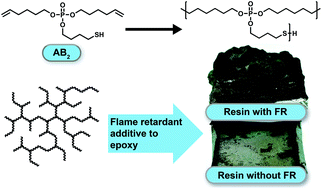First phosphorus AB2 monomer for flame-retardant hyperbranched polyphosphoesters: AB2vs. A2 + B3†
Abstract
Branched polymers are an important class of polymers with a high number of terminal groups, lower viscosity compared to their linear analogs and higher miscibility, which makes them especially interesting for flame retardant applications, where the flame retardants (FR) are blended with another polymer matrix. Hyperbranched polyphosphoesters (hbPPEs) are gaining more and more interest in the field of flame retardancy, as low molar mass FRs often have the disadvantage of blooming out or leaching, which is not desired in consumer products. Here, we present the first phosphorus-based AB2 monomer for the synthesis of hbPPEs and assess its flame-retardant performance in an epoxy resin compared to a hbPPE synthesized by an A2 + B3 approach. The hbPPE synthesized from an AB2 monomer exhibited a slightly higher performance compared to a similar hbPPE, which was prepared by A2 + B3 polyaddition, probably due to its higher phosphorus content.

- This article is part of the themed collection: Polymer Chemistry Lectureship Winners


 Please wait while we load your content...
Please wait while we load your content...